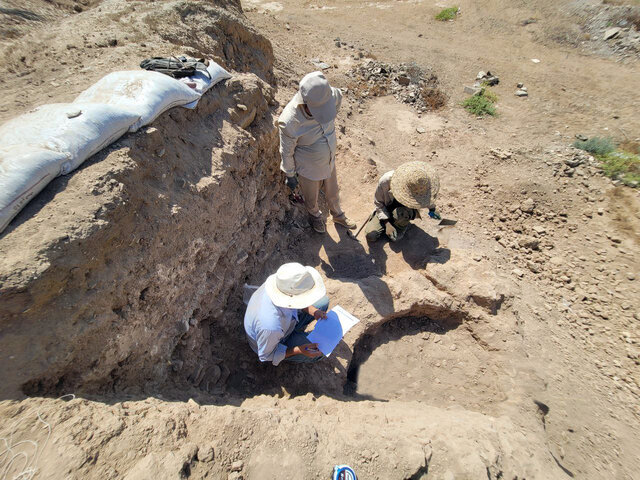Archaeological survey begins on Ahvaz plain of Khuzestan province
TEHRAN – An archaeological survey has commenced on the Ahvaz plain in Khuzestan province, southwest Iran, focusing on a natural mount located in the Asiye-Abad region. Supported by the Khuzestan Cultural Heritage, Tourism, and Handicrafts Department and approved by the Research Institute of Cultural Heritage and Tourism, this initiative marks the first phase of studies

TEHRAN – An archaeological survey has commenced on the Ahvaz plain in Khuzestan province, southwest Iran, focusing on a natural mount located in the Asiye-Abad region.
Supported by the Khuzestan Cultural Heritage, Tourism, and Handicrafts Department and approved by the Research Institute of Cultural Heritage and Tourism, this initiative marks the first phase of studies aimed at documenting, stratigraphic excavation, and expanding research on the Ahvaz plain.
The Asiye-Abad mound, a natural geological formation extending roughly east to west, stands as a significant landmark, rising 30 meters above sea level, ISNA reported.
Due to its prominence on the flood-prone plains, this mount is deemed to have drawn the attraction of various settlements in the course of history.
Archaeological evidence from nearby regions like Hasirabad and Asiye-Abad indicates the importance of this feature in drawing inhabitants in ancient times.
While smaller settlements on the Ahvaz plain may have been buried under sediment over the centuries, the elevated location of Asiye-Abad has preserved it from such deposits. Standing 15 meters above the surrounding land, the mound provided an ideal spot for ancient settlement, particularly on its southern slopes, which offer a favorable angle relative to sunlight, the report explained.
Despite Ahvaz’s strategic significance during the Sassanid and Islamic eras, the area has seen limited archaeological attention. Significant archaeological sites in the Khuzestan region, such as the Iwan-e Karkheh, Susa, and Shushtar, have been extensively studied, yet the historical layers of Ahvaz itself remain under-explored.
As mentioned by the provincial cultural heritage department, the current survey aims to fill this gap, focusing on the cultural and historical aspects of the region.
Previous surface investigations have revealed that Asiye-Abad contains a wealth of Islamic-period artifacts, including a range of pottery and other cultural remains, such as fragments of stone columns.
According to the department, before the excavation begins, systematic surveys and satellite imagery will be utilized to determine the precise location of trenches to be carved. “Aerial photography and the creation of detailed topographic maps will further aid in excavation planning.”
So far, a vertical trench measuring 3×3 meters is planned for the southwestern portion of the mound, which has been identified as having the richest cultural layers based on surface finds.
“This area is expected to provide critical evidence regarding the settlement patterns and architectural styles of the ancient city of Ahvaz, helping to unravel its historical complexities.”
According to the cultural heritage department, findings from this excavation could shed new light on the evolution of settlement in the Ahvaz region and provide greater insight into the cultural history of southwest Iran.
Situated at the head of the Persian Gulf and bordering Iraq on the west, Khuzestan was settled about 6000 BC by a people with affinities to the Sumerians, who came from the Zagros Mountains region. Urban centers appeared there contemporaneous with the first cities in Mesopotamia in the 4th millennium.
Khuzestan, according to Encyclopedia Britannica, came to constitute the heart of the Elamite kingdom, with Susa as its capital. Alexander the Great took Susa shortly after the Battle of Gaugamela in 331, and from 311 to 148, Khuzestan was a satrapy (named Susiana) of the Seleucid empire, with its capital at Seleucia on the Eulaeus River.
The region was passed firmly into Parthian control between 148 and 113 BC and then under Sasanian rule about 226 CE. Moreover, it was a frontier zone between the Roman-Byzantine and the Parthian-Sasanian empires and finally was taken by the Arabs in about 642.
AM
برچسب ها :
ناموجود- نظرات ارسال شده توسط شما، پس از تایید توسط مدیران سایت منتشر خواهد شد.
- نظراتی که حاوی تهمت یا افترا باشد منتشر نخواهد شد.
- نظراتی که به غیر از زبان فارسی یا غیر مرتبط با خبر باشد منتشر نخواهد شد.






ارسال نظر شما
مجموع نظرات : 0 در انتظار بررسی : 0 انتشار یافته : 0